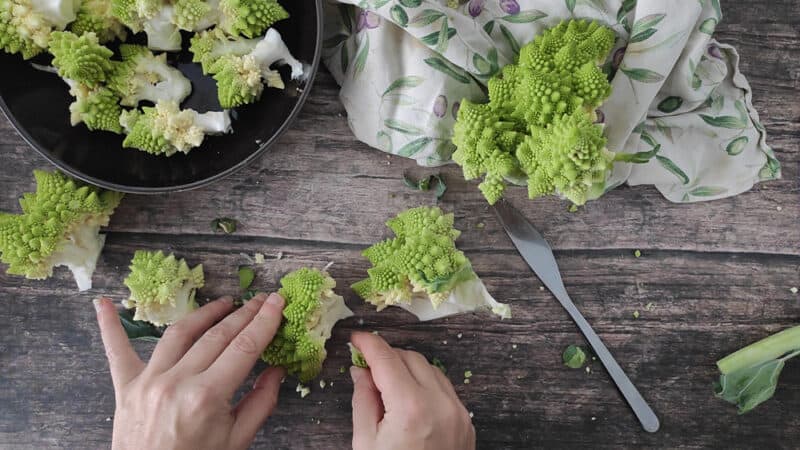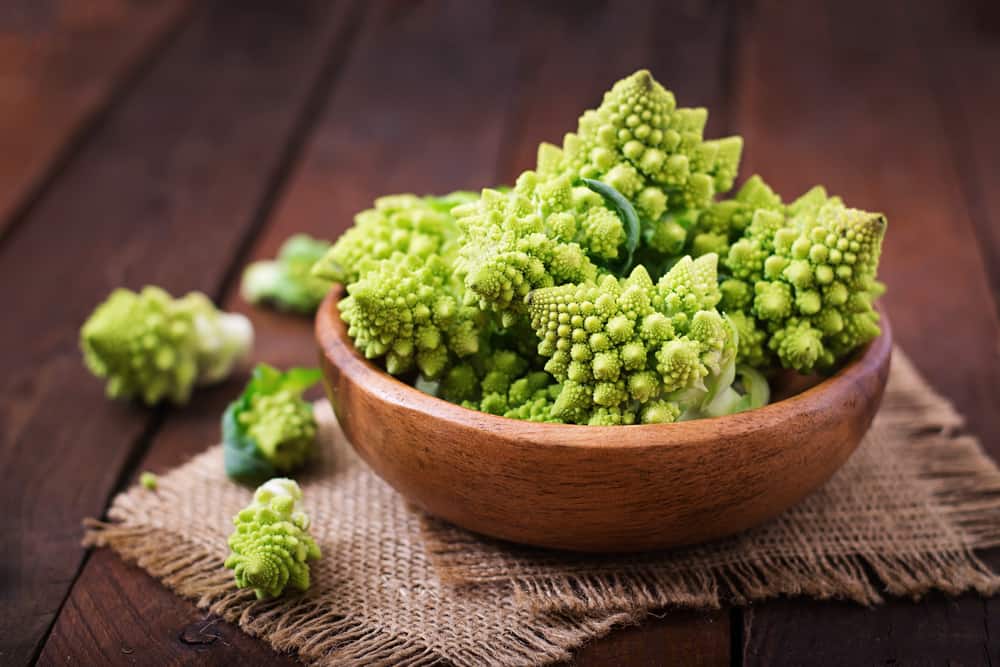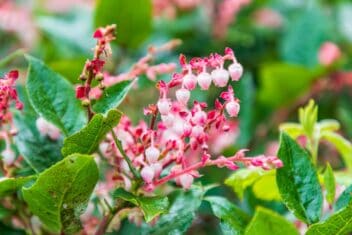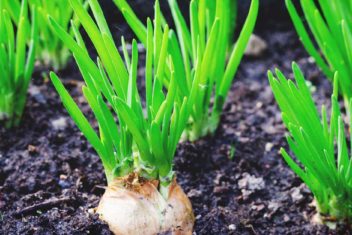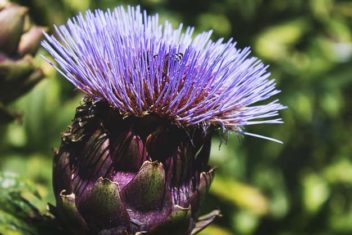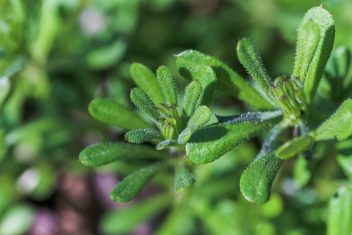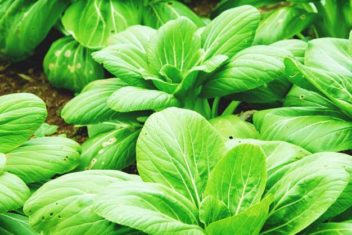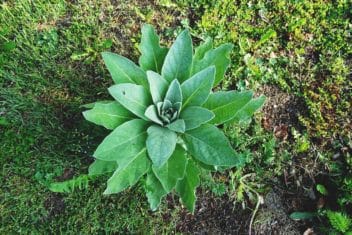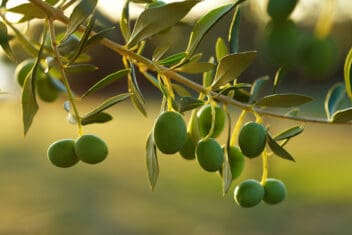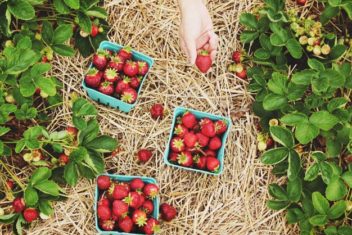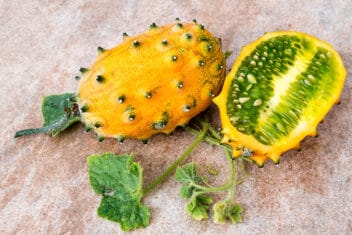Some vegetables you just have to try growing at least once, and romanesco, with its fractal form and unique flavor, is one such plant.
If you’re looking for something different from the standard broccoli or cauliflower, romanesco is for you. It has an earthy, nutty flavor that sets it apart from its similar-looking cousins.
Romanesco is one of the most noticeable veggies at the market, though it can be hard to find and it costs a pretty penny, too. Why not grow it, instead?
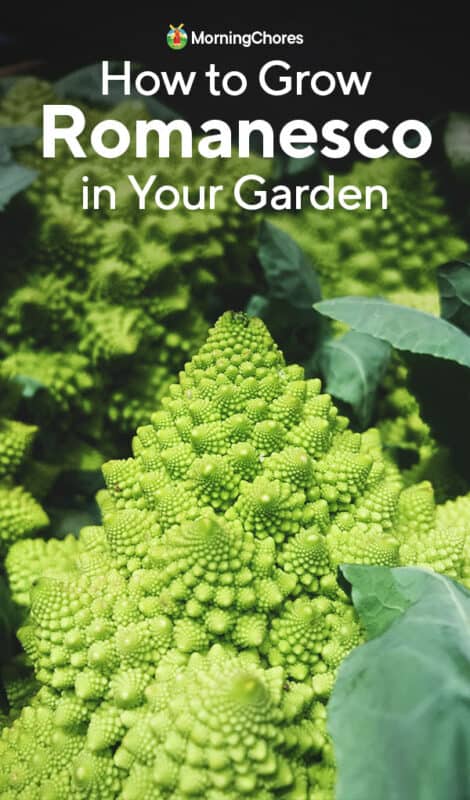
What is Romanesco?
Not broccoli, not cauliflower, romanesco is commonly called Roman cauliflower, Roman broccoli, and fractal broccoli, but it’s actually a member of the brassica genus known botanically as Brassica oleracea var. botrytis ‘Romanesco.’
It was cultivated near Rome (hence the name) using selective breeding in the 15th century by Italian growers.
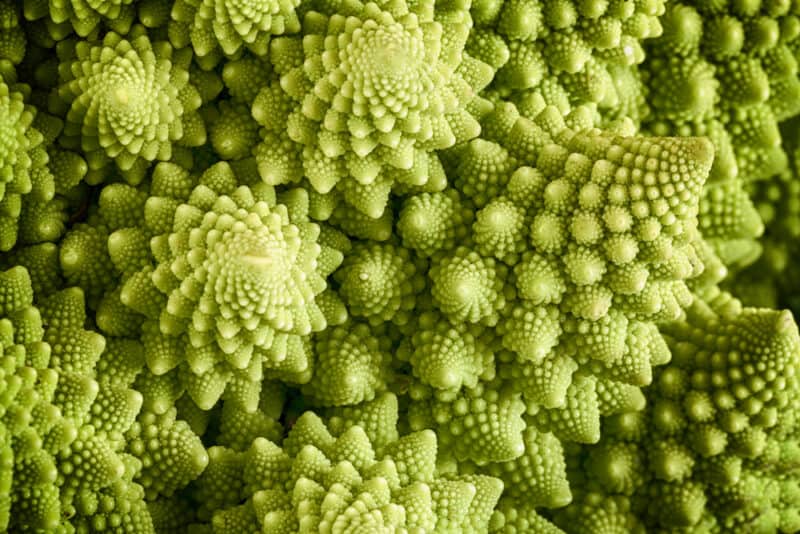
Like broccoli and cauliflower, the part we harvest and eat is the edible flower of the plant. The florets are made up of fractal spirals that repeat, giving romanesco its unique appearance.
Romanesco is not only a cool-looking vegetable, but it’s also good for you. It’s high in vitamin C and K, carotenoids, and fiber.
If you want to grow this amazing-looking, delicious cool-season plant, let’s get going.
Best Varieties of Romanesco
There are three main varieties commonly available. They differ slightly in size, color, and taste. Try them all if you can and see which you prefer.
Veronica
This is a common and popular variety because it is quick to mature and has the biggest heads. It’s prolific and can be harvested quite young, which makes the taste sweet and the flesh tender.
Cook ‘Veronica,’ or eat it raw. Light green in color, the plant will grow up to 30 inches tall and 18 inches wide. The heads will be up to seven inches wide and are ready for harvest in as little as 80 days.
Natalino
‘Natalino’ is a great variety if you want to harvest the baby heads to eat whole. It’s alsos just as nice fully grown and cut up. It has a lighter green color, with a slight yellow tinge.
You can harvest ‘Natalino’ in about 90 days, so it’s good in areas where the growing season is shorter.
Gitano
‘Gitano’ is a hybrid variety. It’s especially resistant to mildew compared to other varieties. If you live in a cool area, this is a good one to plant because it’s especially cold-resistant.
This cultivar is a darker green than the other varieties and grows to about 18 inches tall and 24 inches wide. You should be able to harvest ‘Gitano’ in around 110 days. The head will weigh up to three pounds.
How to Plant Romanesco
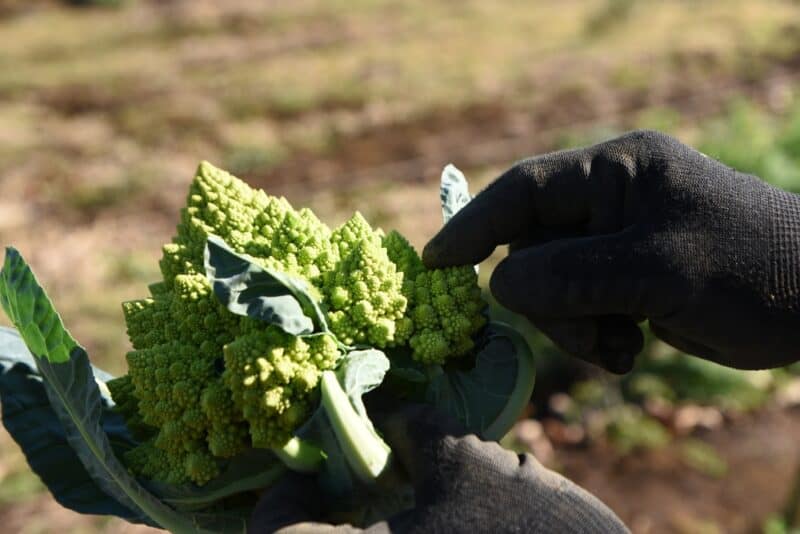
Being a cool-season crop, romanesco thrives in daytime temperatures around 70ºF and no lower than 40ºF at night. Romanesco can be found growing well in USDA Zones 3-10.
Plant in loose, loamy soil that drains well. Dig in well-rotted organic matter at least a week before planting. The soil pH should be 6.0 to 7.5.
Plant in full sun with afternoon shade, if available, though the shade is optional.
Space about 18 inches apart. Although not a huge spreader, we still want good airflow between the plants.
Propagating Romanesco
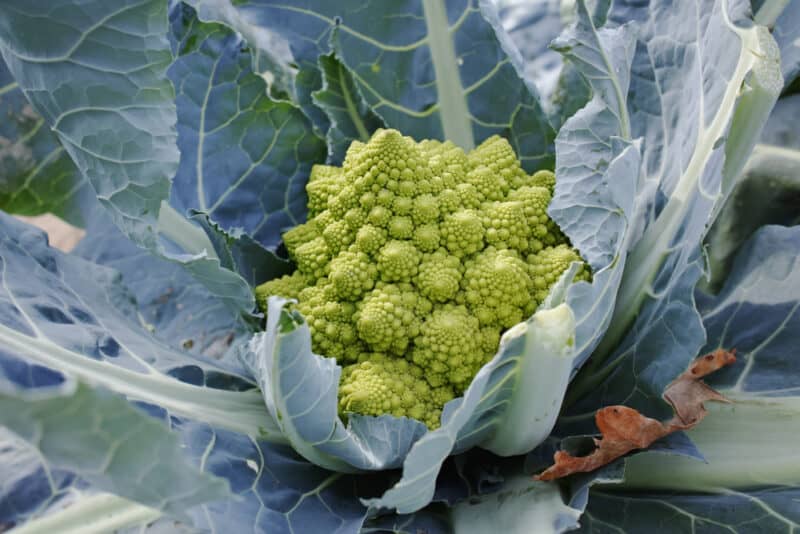
There are two methods for propagating romanesco. You can grow from seed, which is the money-saving way, or by planting starts or seedlings if you can get them from a local nursery.
Seed
Plant seeds indoors about eight weeks before the average date of the last frost in your area. You want the majority of the growing to be outdoors after you transplant your romanesco in late spring or early summer.
If you live in a warm area with mild winters, plant indoors in late summer and transplant outside in mid to late fall.
You should grow a bunch of the plants for several reasons. One, they’re delicious. Two, they don’t take up much room, and three, they can be a challenging plant to grow so best have some extras.
Here are the steps to planting seeds:
- Use a seedling tray or individual pots.
- Make a hole 1/4 inch deep, and place two seeds in the hole.
- Cover with more soil mix and mist with a spray bottle.
- Cover the container with a lid if it came with one, or use a plastic bag.
- Keep the soil moist for around 21 days when you should see germination.
- When you see the green tips push through the soil, remove the plastic lid or bag.
- Keeping the plants inside, move them to an area where they will get as much sun as possible. Keep watering.
When the plants are at least four to six inches tall and have two leaves, start hardening them off. Move them outside for increasing amounts of time over one to two weeks.
Transplant them into your garden when ready using the method for seedlings below.
Starts/Seedlings
If you’re short on time, choose starts from a nursery and plant after the last projected frost. Dig a hole in the ground the same size as the container. This makes it easier to transplant, and you’ll avoid damaging the tender roots.
Remove the seedling and soil from the container and place it in the hole, gently firming down. Plant seedlings 18 inches apart.
Place in the hole and backfill with garden soil. Tamp down and water well.
Caring for Romanesco
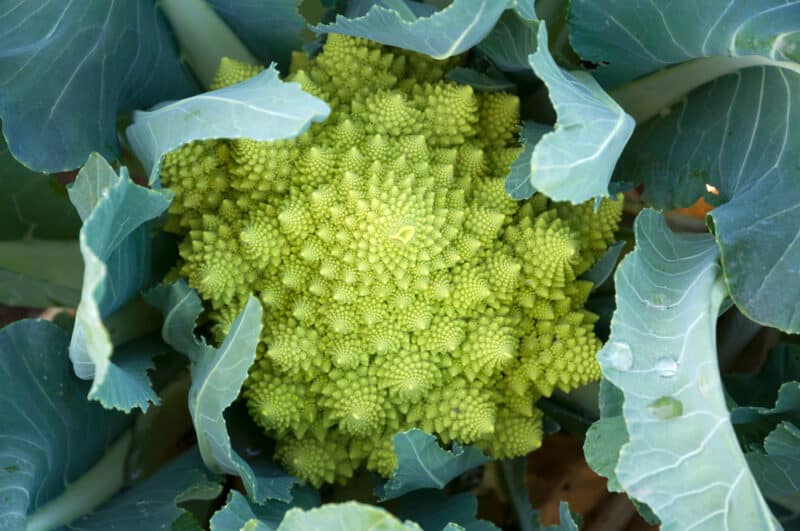
Once the romanesco plants have been growing a bit and are at least 10 inches tall, it’s time to give them a little fertilizer.
Use a balanced 5-5-5 NPK fertilizer according to the instructions on the pack. Dig the fertilizer into the first three inches of soil, being careful not to damage the roots of the plants.
Romanesco needs about an inch of water per week. Consider setting up a rain gauge and providing additional water if there is a shortfall.
Another easy method is to stick your finger down a couple of inches. If the soil is dry to your first knuckle, provide water. If the soil is still damp, hold off and check the next day. Inconsistent watering is one thing romanesco doesn’t like.
Keeps weeds away while the romanesco is young and just starting. Weeds will steal the nutrients the plant needs for the rapid growth and the formation of the head.
Companion Planting for Growing Romanesco
Plant things with romanesco that prefer cooler temperatures such as:
- Yarrow
- Fennel
- Artichokes
- Dill
- Chard
- Beets
- Mint
- Peas
- Potatoes
There are a few things that romanesco doesn’t grow well near:
- Strawberries
- Garlic
- Leeks
- Radishes
- Shallots
- Rutabagas
- Tomatoes
Common Problems and Solutions for Growing Romanesco
Like all brassicas, romanesco has quite a list of pests and problems that plague it.
Cauliflower Mosaic
This is a virus spread by aphids. There is no cure for cauliflower mosaic, so the best you can do is control the pests like aphids with neem oil.
Signs of cauliflower mosaic include yellowing of leaves, stunted growth, and leaf veins that look translucent.
Fusarium Wilt (Fusarium Yellows)
If you find your plant has yellowing leaves that fall off, stunted growth, browning of the veins or drooping lower leaves, you may have fusarium wilt or yellows, caused by fungus in the Fusarium genus. Read our article on how to spot and deal with fusarium wilt.
Blackleg
This is a fungus that affects the stem and leaves of romanesco. Wet and windy conditions, followed by high heat and humidity sometimes lead to blackleg.
You’ll see brown lesions with a purple outline filled with little black dots. Once it’s on one plant it can spread via wind, water splash, or your garden tools.
There is no treatment for blackleg, but you can reduce the chances of it occurring.
Good garden hygiene is paramount. Clean tools, rotate crops, remove infected plants from the property, and inspect your seedlings before transplanting. Blackleg can even be present in seeds so purchase certified disease-free seeds.
If you grow potatoes, take extra care. Use only good quality, treated, and certified seed potatoes as blackleg is common in potatoes and the fungus overwinters in the soil.
Flea Beetles
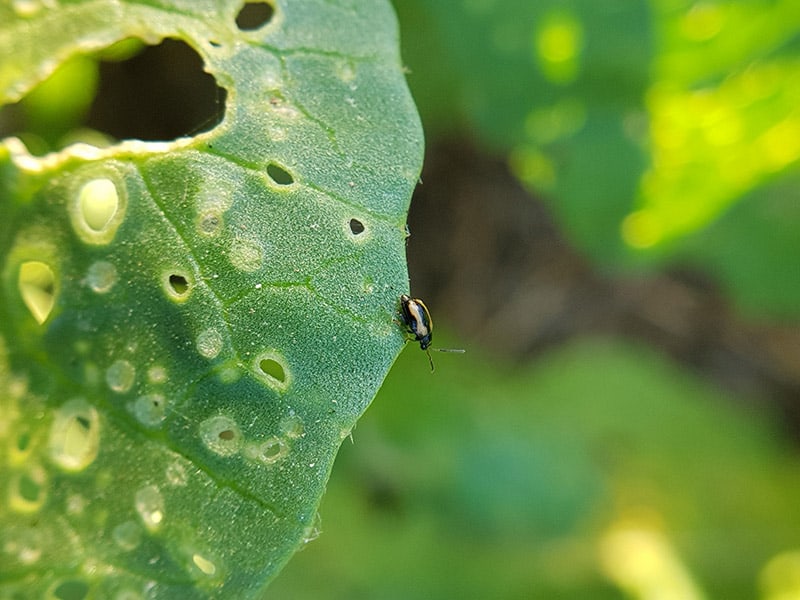
Seedlings and young romanesco plants are in the most danger from flea beetles. In mid to late spring when temperatures begin to rise is the time flea beetles emerge.
The larvae feed under the soil, but the damage you’ll notice is on the foliage from the adults. You’ll see lots of little holes in the foliage.
When the numbers grow, you’ll need to deal with them with an insecticide like organic pyrethrum. To avoid them in the first place, rotate crops regularly and clean your garden tools. Check out our guide to flea beetles for more helpful tips.
Diamondback Moths
Diamondback moths are in the garden, especially around brassicas, for most of the growing season. Their young feed on the foliage and are considered destructive pests that can be hard to control. In some warm regions, they breed all year, resulting in up to 15 generations per year.
The caterpillars feed on leaf tissue. They eat from the bottom of the foliage, leaving the veins and upper layer of the leaf intact. If you notice this kind of damage, look closely for the worms.
Consider using trap plants that attract the moth-like collard greens and leaf mustard. This moth has developed resistance to many pesticides, so ask your local extension office for tips on how to address an infestation.
Additionally, make sure you rotate crops and keep your romanesco growing as healthy as possible.
Slugs and Snails
Slugs and snails can devour young plants, causing stunted growth or even killing the seedling entirely. Go out each night with a flashlight and search for the little jerks. Pluck them up and drop them in a glass of soapy water. For more tips, head to our guide on snails to learn how to control and eradicate the problem.
Cabbage Loopers
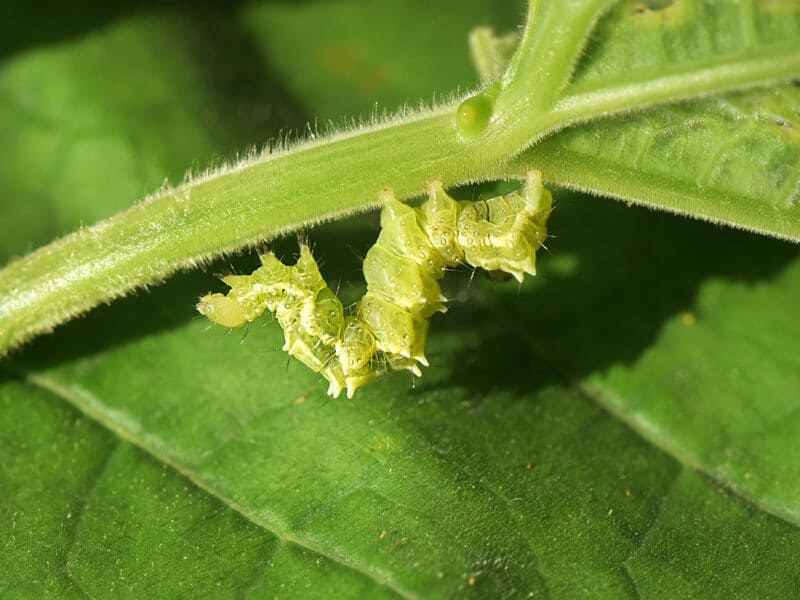
Any plant in the cabbage family is susceptible to cabbage loopers (Trichoplusia ni). These little insects are sometimes called inchworms because of the way they inch along. To learn how to deal with them, check out our article on cabbage loopers.
Cabbage Worms
Cabbage worms (Pieris rapae) are extremely common and feed on a variety of plants, not just cabbages. You’ve probably seen the little white butterflies with the small dark spot flitting around your garden. Those are the adults. They’ll lay eggs that will eventually hatch into small green worms that will absolutely devour your plant.
Natural predators like wasps and ladybeetles will eat the eggs and larvae, but you might need to turn to chemical controls. Use a natural control like a spray containing Bacillus thuringiensis kurstaki.
Harvesting Romanesco
Now for the most fun part of growing romanesco: harvest time! You know your heads are ready to harvest when they’ve reached their mature color and the little florets are just starting to separate. Don’t wait much longer. Once the florets separate, bugs and diseases can sneak in and ruin your crop.
Of course, you can use romanesco as you would broccoli or cauliflower. That means you can steam it, sautee it, boil it, bake it, fry it, or process it to make rice or pizza crust. Seriously, let your imagination run wild!
